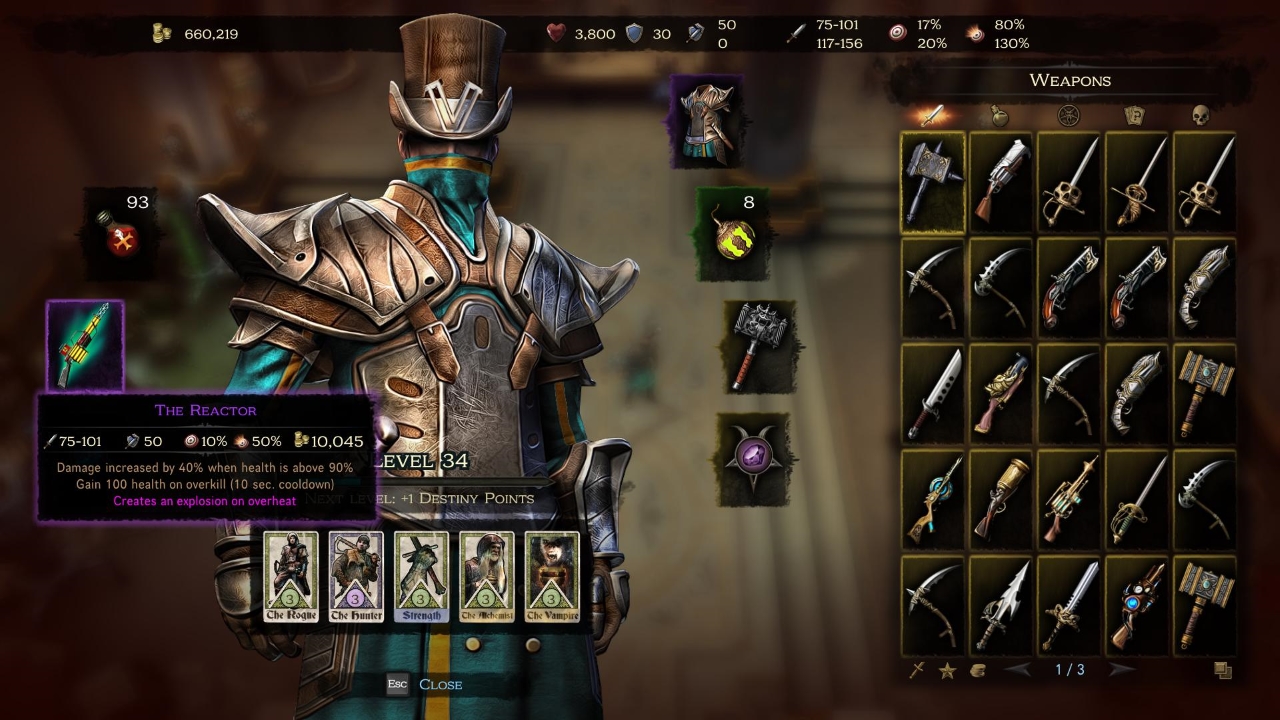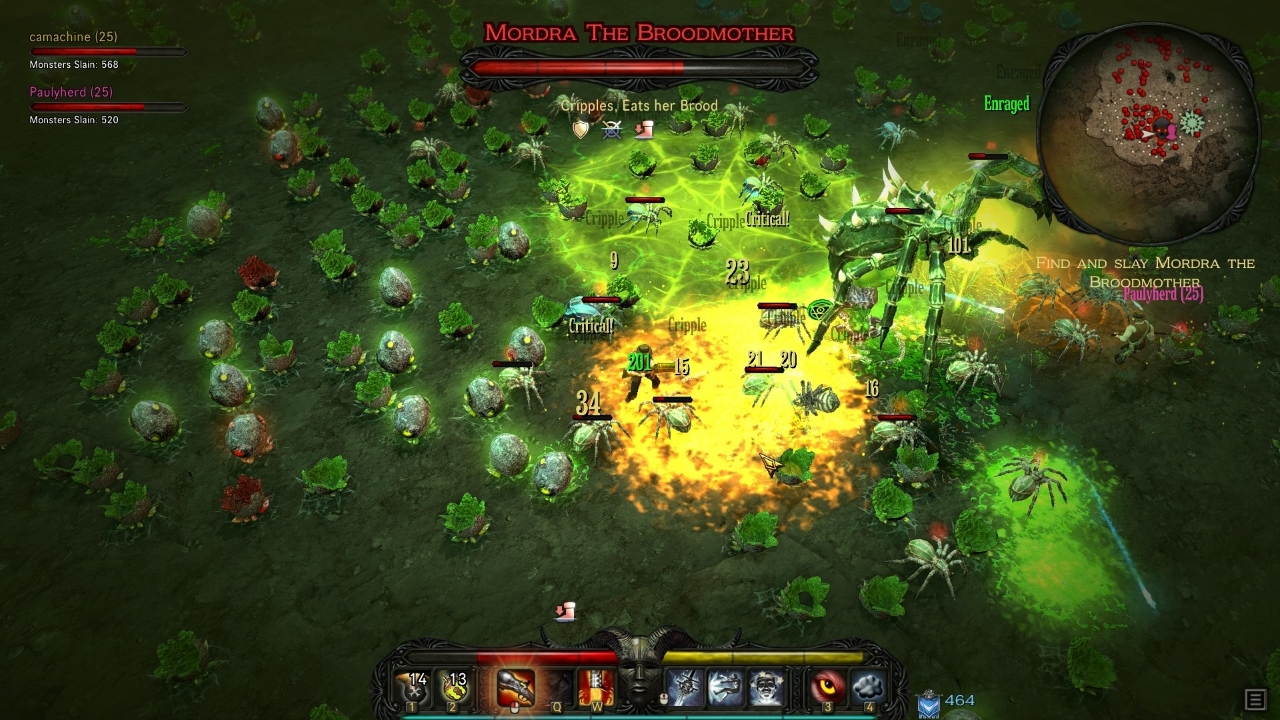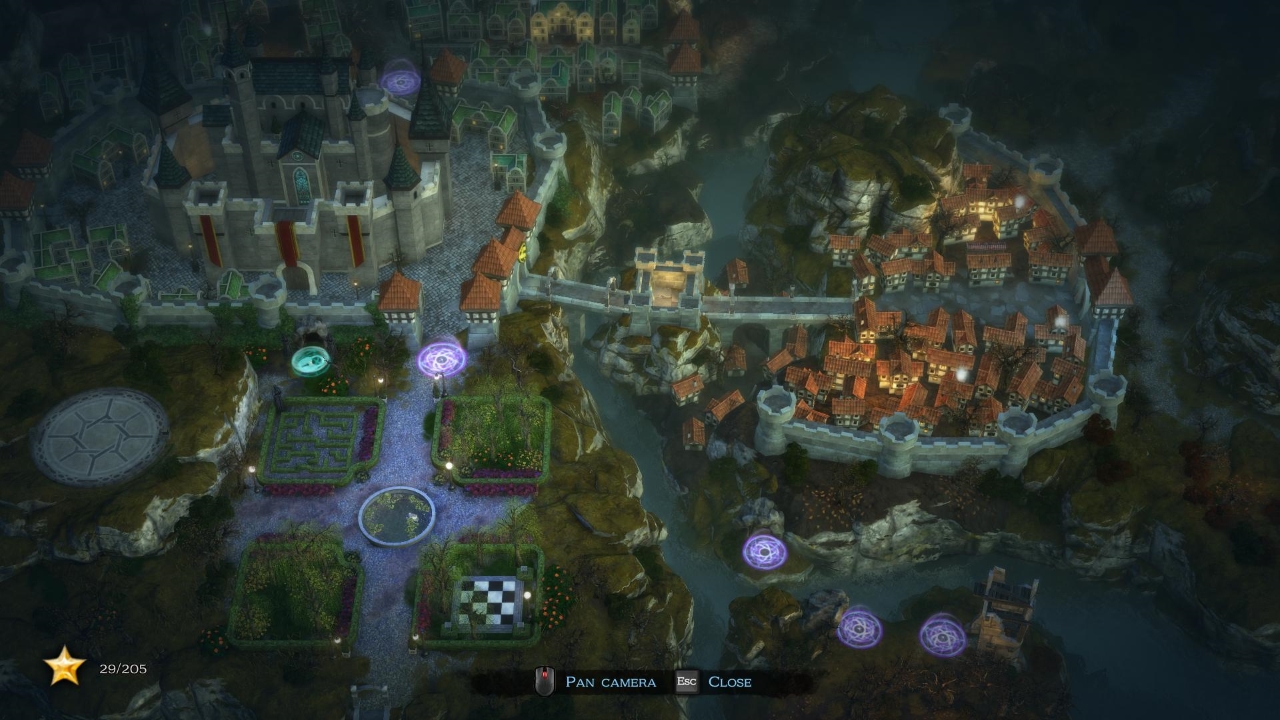Victor Vran won’t light any new fires. Well, in a way, fires will occur, but they’re more of a demonic nature. What I mean is that the game doesn’t quite reach the heights of its roleplaying peers. It isn’t completely without its own small surprises, though, such as offering an enjoyable way to craft a custom character, as well as enticing combat and eye-catching visuals. Even though the loot-charged game has plenty of issues, the makings of something good are underneath its foibles.
You are strapped into the worn, blood-caked boots of the eponymous Victor Vran, demon hunter by trade. At the beckoning of his friend and fellow hunter, Victor travels to Zagoravia, a gloomy city fallen into darkness. Demons prowl the streets; skeletons burst out of the ground to attack with slashing blades; gigantic spiders descend from cave ceilings on sinewy threads to lash out with dripping fangs; and powerful vampires rip out your very life essence. But these are garden variety beasts, not enough to surprise veteran action RPG fans. The story isn’t anything special: a dark fantasy theme bolstered by archetypal enemies ready to be slaughtered by the hundreds. Indeed, in Victor’s boots you’ll find yourself traveling along the same well-trodden path of games like Diablo III and The Incredible Adventures of Van Helsing. But in its defense, Victor Vran does introduce some elements that, while not exactly breaking the mold, help it stand out at least somewhat from the pack.
For example, there are no traditional classes to speak of in Victor Vran. And, as this is Victor’s story, there are also no options to pick different characters of varying styles, backgrounds, or gender. Instead, the character you create is a meld of outfits, weapons, demon powers, and destiny cards, all of which coalesce into a Victor of your own personal design. Every weapon type, from sword to shotgun or scythe, comes matched with two slowly recharging special abilities. For instance, the shotgun offers a spread or precision shot, while the war hammer sends you flying into the air only to come crashing down in a thunderous shock wave. Two weapons can be equipped at once, increasing the abilities at your disposal. You can also equip up to two demon powers, which offer offensive or defensive skills, such as casting an aura that increases physical damage or calling down a pillar of scorching flame. Using these abilities takes overdrive, which gets recharged by use of special outfits, each granting an armor rating and a new look. Destiny cards are a special element of the customization. You can equip a handful of these cards at a time, each one granting an attribute such as gaining health with every strike, increasing critical attack damage, or creating an icy explosion.
Swapping around all these elements on the fly is fast and easy, allowing you to exchange equipment and abilities to match each situation. External factors often play a role in what “class” you choose to run. If I was playing solo, I built a character with high defense, equipping cards that gave me the ability to absorb health, and an increased overdrive recharge rate. But if I was in a party, I would equip the sanguine aura, which healed myself and nearby allies while keeping up my defense. Equip a hammer with this build, and just like that, I had a makeshift paladin. Or I could go in the reverse direction, upping my movement speed and long-range attack damage, and equipping a shotgun to create an agile gunslinger.
Though enjoyable, the customization does come with a caveat. The lack of disparate classes discourages replayability, which causes the game to hit its plateau at around 15 hours. You can keep trudging ever onwards, of course, searching for even better loot or completing many of the in-stage challenges that offer a deluge of rewards. There is also the unlockable Bottomless Pit arena, which sets you against endless waves of powerful enemies for a chance at rare loot. But I found these distractions to be merely that: distractions that were not compelling enough to pique interest for very long.


The exciting, fast-paced combat is easily the game’s best feature. Battles crackle with energy as you fight mobs of enemies. Demonic powers clash, creating a lightshow of glowing neon colors as ice, electricity, and fire dance across the field. Combat is hard-hitting and immensely satisfying, and watching as a large group of creaking skeletons explode into chunks of bone from a shotgun blast or well-placed bomb never gets old. The battle--and really, the game as a whole--are even better when bringing in up to three allies who add their own particular abilities, creating a maelstrom of intense energy. The difficulty rises naturally as you progress, although you can activate up to five hexes that increase the challenge and reward you in additional experience points and items.
Unfortunately, the enjoyment combat brings doesn’t completely escape unscathed. Victor Vran’s hectic battles can get confusing, especially since many of your foes wield the same demonic powers as you and your allies. Due to this, it often becomes difficult to differentiate between the powers of friends and enemies until you get smacked by a damaging blast that chips your life away. Also, when the combat gets loud and heavy, it’s not unusual to notice lag spikes, causing allies and enemies alike to zip around on the screen for a second or two before settling down. The boss fights are generally forgettable. At one point in the story, you will fight and defeat a large spider boss, only to fight another spider boss not long after--this second one made even more boring due to its predictable attack and movement pattern. Worst of all, however, is the weight of tedium that increases the longer you play. The severe lack of enemy variety hurts longevity. There are only so many enemy variants, and most of the time stronger opponents are merely palette swaps of the same enemy type.
The option to roll and jump in Victor Vran does make the combat more nimble and faster-paced than that of its RPG cousins. Rolling allows you to quickly dodge oncoming attacks and move around a skirmish quickly. Jumping is a great addition, allowing you to hop onto higher platforms and rain hellfire onto enemies below. It also allows you to experience brief instances of platform jumping when the path ahead of you has gaps to cross. You can even wall-jump, which grants you access to even higher ledges or hidden areas with secret treasure to pilfer. The jumping isn’t perfect, however, as you’re unable to go from a higher platform to a lower one without having to jump down, which feels awkward.
Also, there are areas with walls you can wall-jump over (though this doesn’t make sense in buildings or shafts where a ceiling would prevent such a maneuver). That is, if the game’s controls even allow you to make the jump. By default, Victor Vran employs a control scheme that features movement with directional keys, as opposed to the mouse. It’s a strange choice for this type of game, and I couldn’t get comfortable with the limited scope of movement. You can choose the mouse-only control scheme, used by most games of this genre, but it’s absolutely horrid. Movement is broken, causing you to fight to get to where you want to go. Trying to jump using the mouse is nearly impossible, as you must click as close to the edge as possible before hitting the appropriate key. Most of the time, Victor will leap straight up in the air while sometimes performing a little twirl, before landing and making you try again.

Typically in games of this type, holding down the left mouse button causes your character will move in that direction. But here, if you move your mouse past a nearby wall or ledge, Victor will immediately start following a path directly to where your mouse is pointed, instead of moving in that direction. Confused regarding your intent, he stutters in a circle--a move that becomes more aggravating the longer you play. You can’t even pass behind a pillar or under a stone archway without the pathfinding getting befuddled and causing you to briefly pause in place. On top of this, Victor also frequently gets stuck on walls and objects. The directional key movement is better, but I found using the controller to be the best solution, as it removes any major problems associated with the other two options. The auto-aim also could use some tweaking of its threat detection, as more than once you’ll find yourself blasting apart boxes or couches instead of a demon just off to the side.
Killing heaps of Victor Vran monsters is only half the fun; the rest is stuffing your pockets with as much loot as possible. You travel throughout Zagoravia, greedily scooping up dropped goods, including weapons, gold, destiny cards, outfits, and dyes, which add a splash of color to your look. Items are picked up simply by walking over them. And with your enormous personal inventory and the pace of the game constantly pushing you onward, you will rarely stop for long as you move onto the next set of enemies in hungry anticipation of even more spoils. Most items you stash away are junk, but they’re never completely useless. Castle Zagore, the game’s central hub where you stage your fight against the supernatural, includes shops to sell old loot or buy something new, as well as a storage chest to store excess items. Then, when you reach level 16, you gain access to the transmutation machine. With it, you can combine unwanted items for the chance to create something better or to improve the stats of gear you want to keep. When it comes to loot, those are your only options, as you can’t trade with your fellow players. So if your friend happens to pick up a weapon or destiny card you need--well, that’s tough luck. You have to find or purchase your own gear.
Victor Vran’s steampunk-inspired world is very detailed, featuring destructible objects that break or shatter across the ground as combat heats up. Leaves fall gently from trees, crystal formations glow with a soft light in caves, and green mists float gently over desecrated cemetery grounds. The city streets are lined with houses, as well as shops with goods you can see through windows, and tall buildings. Most tall structures and obstacles crumble out of view when the camera draws close, allowing you to peer through. However, sometimes those objects don’t melt away, obstructing the screen. You can swing the camera around for a better view, but needing to reposition it at every other fight becomes irritating fast. Being attacked while fidgeting with the camera is another annoying reality you’ll sometimes have to face.

Character development is close to nil, but the vocal work is actually not bad at all. Victor himself is voiced by the gravelly, monotone Doug Cockle, instantly recognizable as the man behind Geralt of The Witcher fame. The most standout character, however, is almost impossible to ignore. Throughout the story, you hear the voice of a mysterious man who calls himself, well, “the voice,” who on occasion talks to you telepathically. His helpfulness, however, is debatable. He chimes in from time to time, either to play a quick prank on Victor or insult his hat--though some of his dialogue can be clunky at times, and his sense of humor is a tad aged. I mean, how much longer must we endure that damn “arrow to the knee” joke?
This odd narrator does add some humor to Victor Vran, but it’s not like the game is completely devoid of playfulness. It slips in plenty of references ranging from Skyrim to The Ghostbusters. On occasion, you’ll also run into a horde of dancing skeletons that send out a damaging aura that forces you to dance along. It is funny, though I would have found it more amusing if the choreography wasn't based on the "Gangnam Style" dance. Oh, and let’s not forget about the legendary hand mortar that fires exploding chickens. Because that’s a thing you can actually get.
There are problems with just about every aspect of Victor Vran. The issues range from small to large, from the glitches to frequent crashes and audio cutouts. Still, there’s a lot to enjoy about it. Not only is it aesthetically pleasing, but the entertaining combat, above all else, is what would get me to return and burn away more hours hunting the creatures of the night. The lack of content and variety is a concern, though this may be alleviated with the planned free DLC. Victor Vran has more demons than just the ones that haunt its macabre streets, but with some time and healing, it could end up much stronger.